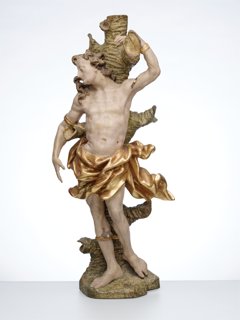Location
Austria, Styria, Graz
Alte Galerie, Universalmuseum Joanneum, Inv.-Nr. P 336 , not exhibited
Original location:
Austria, Styria, St. Radegund bei Graz
Artwork
The sculpture of St Sebastian, Universalmuseum Joanneum, Alte Galerie, Inv.-Nr. P 336
Type
Sculpture
Critical History
The sculpture was bought at the same time as St John of Nepomuk and St Francis Xavier with an altar 1913 from St Radegund.
Wilhelm Suida1 was the first who published the sculptures (Styrian, 18th cent.), Kurt Woisetschläger2 dated them about 1750. The first attribution to Philipp Jakob Straub is hereby done by Christine Rabensteiner who dates them circa 1740 – 1750.
The sculpture embodies a very young Sebastian, whose body and face show the acceptance of his martyrdom. The masters high level of anatomical knowledge is easily recognizable, only the right forearm appears to be static. This Sebastian can be compared with the Sebastian from Egervar in the Museum of Fine Arts, Budapest (Szépművészeti Múzeum, Inv. no. 4963, dated 1757). The posture of the bodies resemble: For instance the position of the left foot is instable, the turn of the head and the falling of a tuft of hair on the right shoulder, and the waving of the cloth on the left hip. Remarkable are the flutes of the tree bark and the deep notches at the end of the branches.
The Sebastian sculpture at the Marian column at Karlau square in Graz (Karlauplatz, dated 1762) is a stylistic continuation which shows more proper motion.
Construction / Execution
Three-dimensional, limewood, polychromed, woodworm infestation inactive. Fabrication (clamping) hole at the top (tree) and on the bottom of the ground visible. On the bottom of the plinth the sculpture shows exactly the same clamping hole as the sculptures of St Francis Xavier, Inv.-Nr. P 186 and St John of Nepomuk, Inv.-Nr. P 337. This means, all three sculptures were made on the same construction unit.
Two arrows are missing today. The left arm and one finger of the right hand were broken and fixed again. The right arm is fixed and repaired visibly with a wooden dowel.
Components
- Sculpture
- Author: Philipp Jakob Straub (Wiesensteig 1706 – Graz 1774)
- Completed: 1740 – 1750
- Technique(s): wood carving
- Material(s): limewood
- Polychromy
- Completed: 1740 – 1750
- Material(s): calcium sulphate dihydrate, gold leaf, oil colour, red bole
Conservation-restoration
- 1960
Treatment Description
Historical repairs: One hole on the backside was closed with a glued wooden part. Added pieces on top and on the side of the sculpture. Some fillings with nitrocellulose/wood.
Originally the incarnate was executed with oil colours. These were reduced, only remnants of the original colours on tree, base and incarnate are visible today.
The original (water) gilding on garment, arrows and rope was restored around 1960 – over remnants of the original gilding. The new gilding on the garment was executed over fillings and red bolus and polished with achate.
- 2018
Treatment Description
The original polychromy is reduced today, partially (only gilding) fillings and a partially second layer was added, and gilded over red bolus.
Images
- The sculpture of St Sebastian, Universalmuseum Joanneum, Alte Galerie (photo by Nicolas Lackner, Universalmuseum Joanneum, Graz, 2018)
- The sculpture of St Sebastian, Universalmuseum Joanneum, Alte Galerie (photo by Nicolas Lackner, Universalmuseum Joanneum, Graz, 2018)
- The sculpture of St Sebastian, Universalmuseum Joanneum, Alte Galerie (photo by Nicolas Lackner, Universalmuseum Joanneum, Graz, 2018)
Catalogue entry prepared by Paul-Bernhard Eipper and Christine Rabensteiner
Recommended citation: Paul-Bernhard Eipper and Christine Rabensteiner, The sculpture of St Sebastian, Universalmuseum Joanneum, Alte Galerie, Inv.-Nr. P 336 , in: TrArS – Tracing the Art of the Straub Family, 2018, (accessed 14/11/2025) URL



